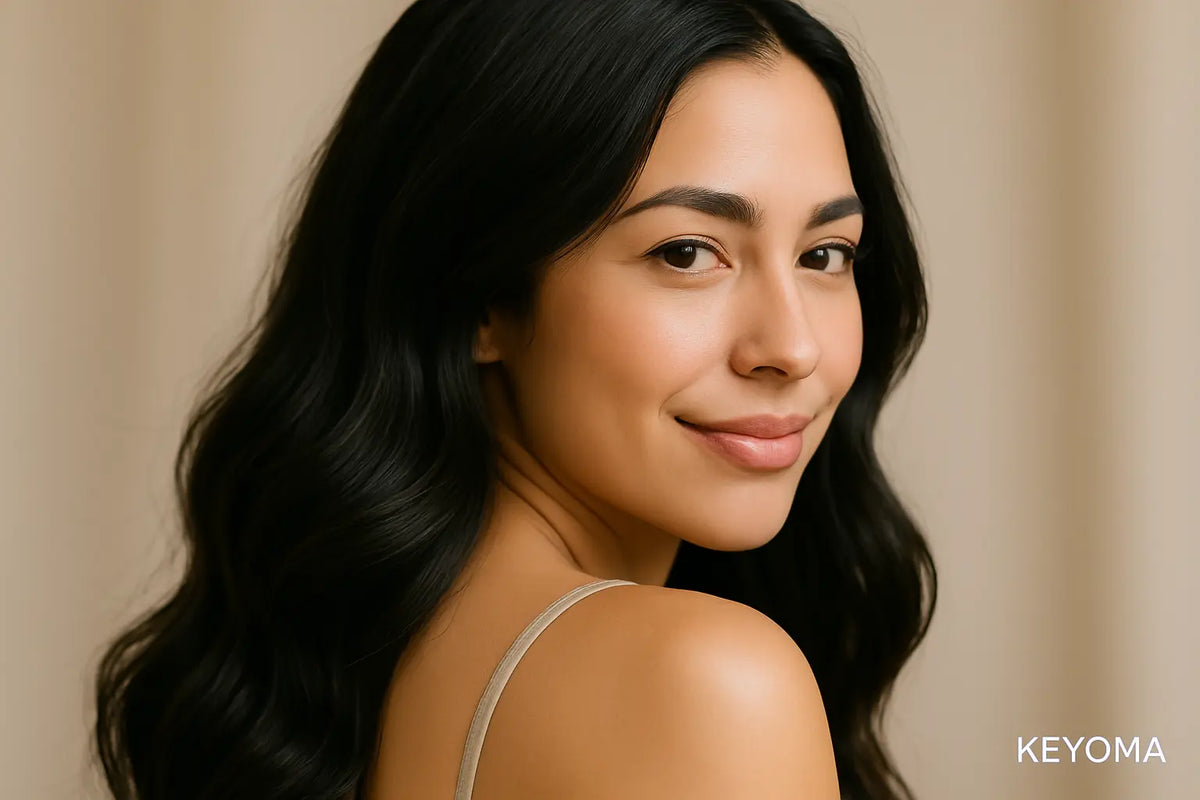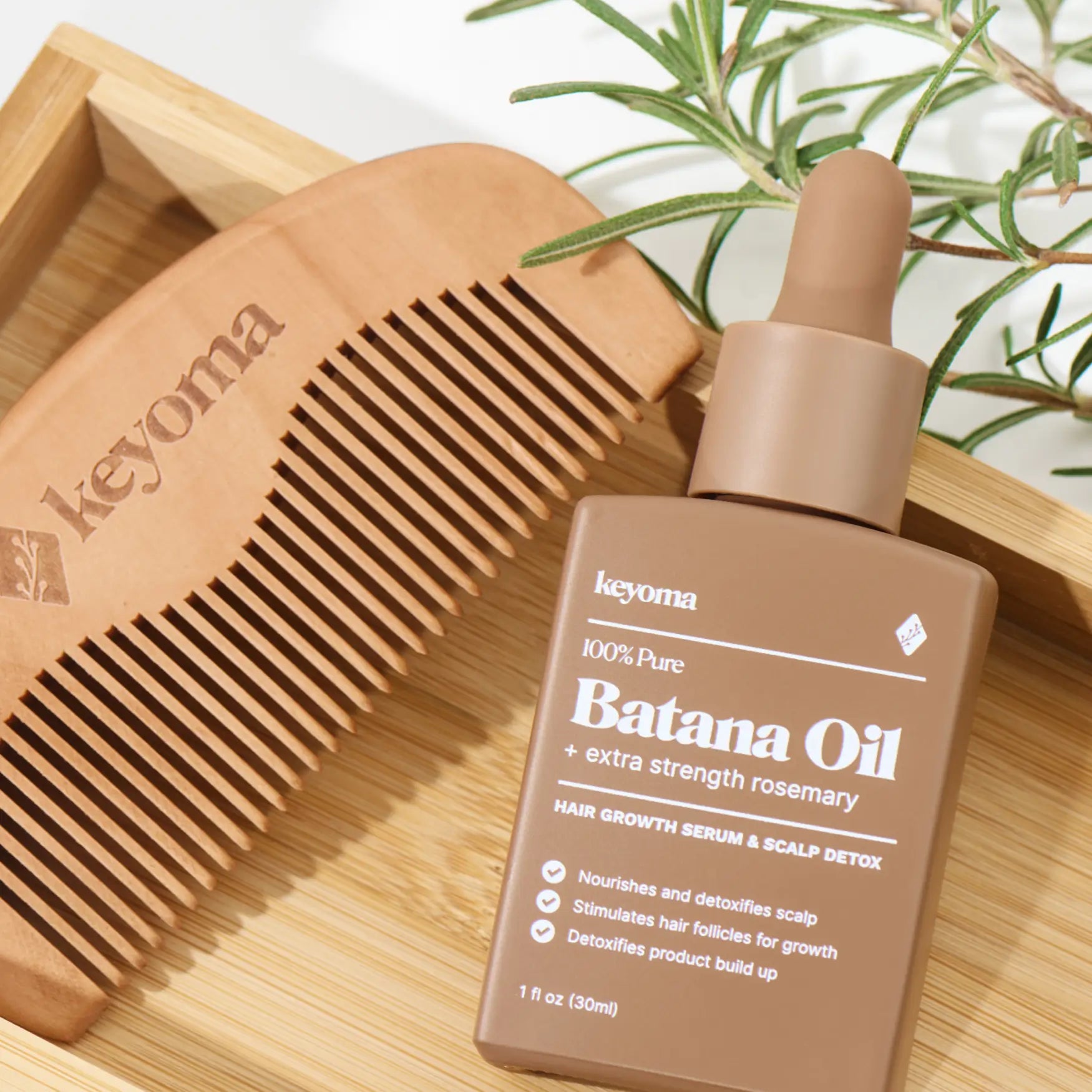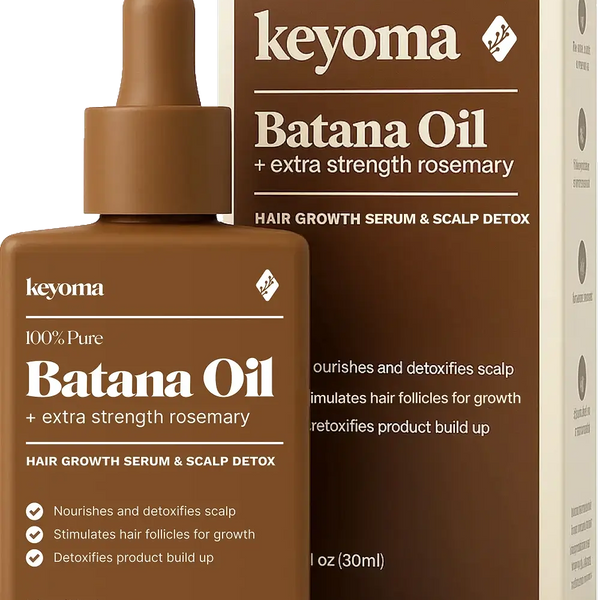In this article
They say the best time to plant a tree was 20 years ago, the second best time is today. Hair growth works the same way. You might look back wishing you cared for your strands sooner, but the good news is—you can start right now with natural remedies that actually support your scalp and follicles.
For us hair girls, that doesn’t always mean running to the pharmacy for lab-made stuff. Nature has given us plenty to work with—oils, herbs, foods, and even simple daily habits—that help create the right conditions for thicker, healthier growth.
In this guide, I’ll share the natural hair growth remedies I’ve tested and used myself so you can decide what fits best into your own routine.
Topical Extracts from Nature
Aloe Vera
Aloe vera has long been used as one of the gentlest herbal hair tonics for supporting growth. Inside its gel are compounds like proteolytic enzymes that help remove excess sebum and dead skin cells clogging the follicles.
By clearing that buildup, oxygen and nutrients reach the root more easily, which supports healthier and more active follicles.
More than that, aloe is also rich in vitamins A, C, and E—all antioxidants that protect the scalp from oxidative stress, which is a big factor linked to hair thinning.
As for how to apply aloe vera, it’s simple—which I suspect is part of why it’s been passed down for generations. Just spread the fresh gel directly onto your scalp after parting your hair, leave it for 20–30 minutes, then rinse with lukewarm water.
Coconut Oil
I bet when you’re chatting hair care with your girlies, or even with your mom or grandma, at least one of them has mentioned or recommended coconut oil for hair growth.
It’s simply one of those trusted natural remedies, passed down through generations and deeply rooted in traditional ayurvedic hair growth remedies.
Its secret lies in lauric acid, a fatty acid that, unlike heavier oils that just sit on the surface, penetrates deep into the hair shaft.
This binding action reduces keratin loss from frequent washing, coloring, or chemical treatments—the very damage that makes strands brittle and prone to breakage. By preserving your hair’s strength, it allows your strands to grow longer without snapping.
Rosemary Oil
Rosemary oil is one of the most studied essential oils for hair regrowth. In fact, a 2015 clinical trial found it performed just as well as 2% minoxidil in improving hair growth within 6 months
The most interesting part? It achieved those results without causing as much scalp itching or irritation, which are common side effects of minoxidil. This makes rosemary oil a truly viable natural alternative, especially for people looking for gentler options
To maximize rosemary oil's benefits for hair, always remember this safety tip first: rosemary oil is highly potent, and direct contact with the scalp can sometimes trigger irritation. Instead of risking harm, dilute a few drops into a carrier oil like almond, jojoba, or batana before applying.
And speaking of batana oil…
Batana Oil
Batana oil is a natural extract derived from the American palm tree (Elaeis oleifera), and it has become popular worldwide thanks to social media buzz. Yet long before TikTok and Instagram, the Miskito people of Honduras—often called the “People of Beautiful Hair”—had used it as part of their daily ritual.
In my humble opinion, when something has been trusted for generations and only later goes viral, you know it’s more than just a passing trend.
Batana oil is a dense mix of oleic acid, palmitic acid, and vitamin E. These compounds work together to repair damaged cuticles, restore elasticity, and reduce breakage—all potent ingredients that can pave the way for real hair growth.
Bee Venom
Bee venom may sound unusual on this list, but it’s actually something that’s been studied in modern times for its regenerative effects on hair.
The main bioactive compound, melittin, triggers a mild inflammatory response that stimulates blood circulation in the scalp. More circulation means follicles receive greater oxygen and nutrient delivery, which encourages stronger growth.
On top of that, it's shown to activate growth factors such as IGF-1, which help extend the anagen (or growth) phase of hair follicles.
I’ve dug deeper into the research on bee venom previously, and honestly, it looks really promising. It shows us that our friendly bees have more to offer than just the sweetness we drizzle on pancakes.
Topical Caffeine
Caffeine is more than just your morning pick-me-up. Applied directly to the scalp, it works as a natural stimulant that helps counteract the effects of DHT, the hormone linked to follicle shrinkage and pattern hair loss.
A 2024 review published in Frontiers in Pharmacology found that when applied topically, caffeine tends to build up inside hair follicles—where new hairs grow—at levels much higher than in the surrounding skin.
In simple terms, caffeine reaches the very part of the scalp where it’s most useful.
The same review also noted that caffeine boosts follicle activity and protects against damage through its antioxidant effects. Together, these actions may help support thicker, healthier strands.
All that said, it shouldn’t be a surprise why several shampoos and serums are now formulated with caffeine.
Dietary Choices & Supplements
Lean Protein
Hair is primarily made of keratin, a structural protein, which makes dietary protein one of the most direct building blocks for growth. When your diet consistently lacks enough protein, your follicles are left undernourished—setting the stage for shedding and thinner strands over time.
You can source lean protein easily from everyday foods like:
-
Chicken breast
-
Turkey
-
Eggs
-
Beans
-
Lentils
If you struggle to hit your daily targets through diet alone, consider whey protein powders or plant-based protein supplements to cover the gap.
Fish Oil
Fish oil is rich in omega-3 fatty acids—primarily EPA and DHA—which are powerful anti-inflammatory compounds. For hair growth, these fatty acids calm scalp inflammation, improve circulation, and nourish follicle membranes.
A healthier scalp environment allows follicles to stay active in the growth phase longer, translating to thicker, stronger hair over time.
You can get omega-3s directly from oily fish such as salmon, mackerel, sardines, and anchovies.
If you’re not a fan of seafood or simply can’t make it part of your diet, fish oil supplements in capsule or liquid form are widely available. Vegan alternatives like algal oil also provide DHA and EPA without relying on fish.
Iron
Iron is essential for carrying oxygen in the blood through hemoglobin, and follicles are especially sensitive to oxygen supply. When iron levels drop, less oxygen reaches the scalp, which can push more hairs into the shedding (telogen) phase.
This is why iron deficiency anemia is one of the most common nutritional causes of hair loss. Adequate iron ensures that follicles remain active and capable of producing strong strands.
You can get iron from both animal and plant-based foods.
Heme iron, found in red meat, poultry, and fish, is absorbed more efficiently by the body. On the other hand, non-heme iron from sources like spinach, lentils, beans, and fortified cereals is also valuable, though pairing it with vitamin C–rich foods helps improve absorption.
Supplements are another option for individuals diagnosed with low iron, but they should be taken under medical supervision.
Vitamin D
Vitamin D is sometimes called the “sunshine vitamin,” and it plays a surprisingly direct role in hair biology. Follicles contain vitamin D receptors, and when these receptors are activated, they help regulate the growth cycle and promote the formation of new follicles.
Low vitamin D levels have been linked to conditions such as alopecia areata and diffuse hair thinning. In plain terms, if you’re deficient, your follicles may spend longer in the resting phase instead of producing new hair.
The most natural way to get this nutrient is through regular sunlight exposure (yes, that beach day counts!). Mornings, when the sun is still soft and refreshing, are ideal.
As for food sources, go for fatty fish like salmon and mackerel, fortified dairy products, and egg yolks.
If you’re found to be deficient, vitamin D supplements are a practical option, but it’s best to confirm your levels with a blood test before starting.
Zinc
Zinc is a trace mineral essential for the enzymes that drive protein synthesis and cell division—two processes your follicles rely on to create new strands. When zinc runs low, the hair cycle is disrupted, pushing more follicles into the resting phase and causing noticeable shedding.
You can get zinc from foods like oysters, beef, pumpkin seeds, chickpeas, and cashews.
Most people can meet their needs through diet alone, but zinc supplements are available if you’ve been diagnosed with low levels.
Ginseng
Ginseng is a traditional herbal remedy often used in East Asian medicine, and in recent years it has attracted scientific interest for its impact on hair growth.
The root contains active compounds called ginsenosides, which are thought to stimulate dermal papilla cells—the very cells in the follicle base that regulate hair formation.
By energizing these cells, ginseng may prolong the anagen (growth) phase and reduce the transition into the shedding phase.
You can source ginseng through teas, powders, capsules, or extracts. Fresh ginseng root can be sometimes added to cooking or brewed as a tonic, but supplements provide more concentrated doses.
Collagen
Collagen is the most abundant protein in your body, and for hair health it serves two main functions: providing amino acids that become the raw material for keratin, and supporting the dermis layer of the scalp where follicles are anchored.
As we age, natural collagen production declines, which can weaken hair structure and contribute to thinning. Supplementing collagen helps replenish those building blocks and maintain a supportive environment for follicles.
You can source collagen through food such as bone broth, chicken skin, and fish skin. However, hydrolyzed collagen supplements (collagen peptides) are more convenient and better absorbed since they break the protein down into smaller, usable fragments.
Collagen supplements are generally safe, but people with food allergies should check the source (marine vs. bovine) before choosing a product.
Hair Care Habits
Scalp Massage
Scalp massage is one of the simplest, most natural habits you can add to your routine for hair growth—and the best part is, it practically costs nothing.
By gently kneading your scalp with your fingertips, you boost blood flow in the tiny capillaries around the follicles. That extra circulation delivers more oxygen and nutrients, helping hairs stay in the growth phase longer.
To make scalp massage even more effective, apply a nourishing hair oil beforehand. These herbal tonics don’t just add slip for your fingers—they also deliver growth-supporting compounds directly to the follicles. Aim for 5–10 minutes a day, using gentle circular motions.
Use Looser Hairstyles
Tight ponytails, buns, braids. All these hairstyles look sleek but they place constant tension on the roots. This repeated pulling can damage follicles, leading to a form of hair loss called traction alopecia.
By choosing looser hairstyles instead, you reduce unnecessary mechanical stress on the follicles. You give your scalp room to breathe and your hair the best chance to grow.
As a compromise, try rotating your styles throughout the week—braids today, a loose bun tomorrow, and hair down the next. Skip rubber bands that snag and break strands, and go for fabric scrunchies or spiral ties instead.
Proper Hair Brushing
In many ways, proper hair brushing works like a scalp massage. It stimulates circulation in the tiny capillaries that feed the follicles. And as we’ve said multiple times, more blood flow means better delivery of oxygen and nutrients, giving your hair a stronger chance of staying in the growth phase.
But brushing is more than just detangling. Every stroke also distributes natural oils (sebum) from the scalp down the strands, coating them for protection and preventing dryness and breakage.
When brushing, choose a wide-tooth comb or a brush with natural bristles to minimize tugging. Always start from the ends and work upward to avoid unnecessary breakage.
And a final tip: never overbrush. Too much can irritate the scalp or damage the cuticle. Once or twice a day is enough.
Enough Rest and Sleep
Rest and sleep may not come in a bottle or jar, but they’re some of the most natural remedies you can give your hair—and one we often take for granted.
While you sleep, your body repairs tissues, balances hormones, and restores energy to cells—including those in your scalp. Growth hormone, which peaks during deep sleep, helps regenerate follicle cells and keeps them active in the anagen phase.
Lack of sleep, on the other hand, can raise cortisol levels, which push hairs prematurely into shedding cycles.
Get 7–9 hours of quality sleep, stick to a consistent bedtime, and create a calm environment. Limiting screens before bed makes a big difference too in helping you sleep more quickly and soundly.
Consistency Is the Real Hair Growth Remedy
All these natural hair growth remedies can help, but none of them work in isolation. Oils, massages, or supplements won’t do much unless they’re part of a habit—and it’s that consistency over time that lets them actually do their thing.
I’ve used hair oils for years now (batana and rosemary especially) and they’ve kept my hair stronger and fuller. But I’m just as certain that cutting down on sugar and processed foods, and focusing more on whole foods, has made a big difference in my hair’s health too.
How about you? Which remedy do you feel like starting with first?
If you’d like more hair tips, routines, and oil blends that actually work, head over to the Keyoma blog. I’ve got plenty waiting for you there!
Featured Product
100% Pure Batana Oil + Rosemary









